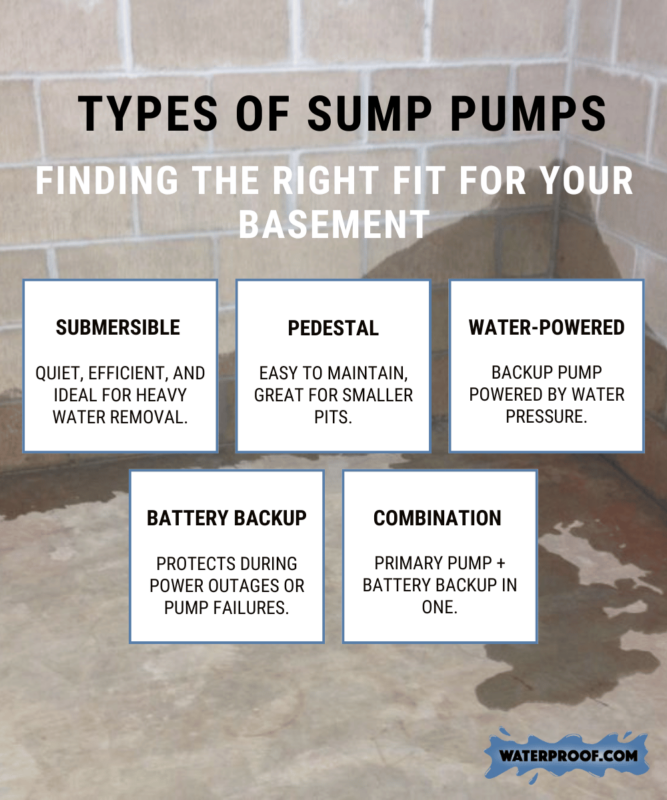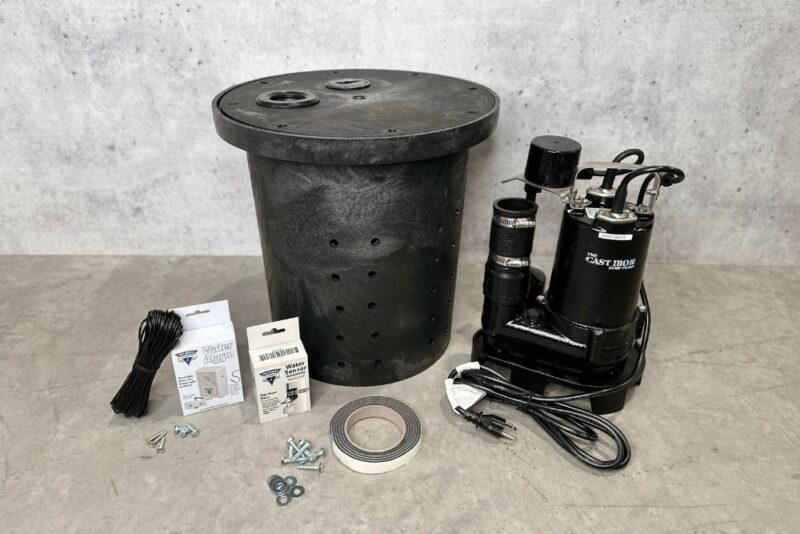A sump pump is a mechanical device designed to keep your basement dry by removing excess water that collects in a sump pit, typically located in the lowest part of your basement or crawl space. When water levels rise due to heavy rainfall, a high water table, or other sources, the sump pump activates and pumps the water away from your home’s foundation, reducing the risk of water damage and basement flooding.
Having a sump pump is especially crucial for homes in areas prone to heavy rain or where the water table is high. This simple yet effective device serves as your home’s first line of defense against potential water damage, protecting not only your basement but also the structural integrity of your home.
In the following sections, we’ll explore how sump pumps work, the different types available, and why they’re essential for homeowners looking to safeguard their property.

How Does a Sump Pump Work? Breaking Down the Basics
A sump pump works by collecting and redirecting water away from your home, preventing potential water damage and basement flooding. Here’s a step-by-step breakdown of how this essential device operates:
The Role of the Sump Pit and Sump Basin:
Water from heavy rain, groundwater, or other sources flows into the sump pit, a specially designed hole or basin located in your basement or crawl space. The sump basin acts as a reservoir, collecting excess water before it becomes a problem.
Float Switch Activation:
As water fills the sump pit, the float switch—a key part of the sump pump system—rises with the water level. When the float switch reaches a certain height, it triggers the pump to turn on automatically.
Pump Operation:
The primary pump (usually a submersible or pedestal sump pump) begins to remove the water from the sump pit. Submersible pumps are installed within the pit, operating quietly, while pedestal pumps have their motor above the basin for easy maintenance.
Check Valve and Discharge Line:
The water passes through a check valve, which prevents backflow into the sump basin. It is then pushed out through the discharge line, directing it safely away from your home, typically to a storm drain, storm sewer, or other drainage area.
Continuous Monitoring:
Many sump pumps include additional features like a sump pump alarm or high water alarm to alert homeowners of rising water levels or potential pump failure.
By efficiently removing water, a sump pump protects your basement from flooding, reduces the risk of mold and mildew, and safeguards your home’s foundation. In the next section, we’ll delve into the various types of sump pumps to help you find the best fit for your needs.

Types of Sump Pumps: Finding the Right Fit for Your Basement
Sump pumps come in several types, each designed to handle different levels of water intrusion and specific homeowner needs. Understanding the types can help you choose the right solution for your basement or crawl space.
Submersible Sump Pump:
Installed inside the sump pit and submerged in water during operation, submersible pumps are quiet and efficient. They are ideal for basements that require frequent water removal and can handle significant water levels.
Pedestal Sump Pump:
With the motor mounted above the sump basin, pedestal pumps are easier to access for maintenance and tend to be more budget-friendly. They are perfect for basements with smaller sump pits or moderate water removal needs.
Water-Powered Sump Pump:
This pump uses water pressure from your home’s plumbing system to operate. It’s a great backup option during a power outage, as it doesn’t rely on electricity or batteries.
Battery Backup Sump Pump:
A secondary pump designed to activate if the primary pump fails or during a power outage. These pumps are essential for homes in areas with heavy rainfall or frequent power outages, offering an extra layer of protection against basement flooding.
Combination Systems:
These systems include a primary sump pump and a battery backup sump pump in one package, providing both day-to-day reliability and emergency preparedness.
Each type has its benefits depending on the size of your sump pit, the level of excess water your basement encounters, and whether you need added features like a backup pump or alarms. Next, we’ll discuss the many benefits of installing a sump pump system to keep your basement safe and dry.
Why Every Basement Needs a Sump Pump
Installing a sump pump provides critical protection for your home. Here’s why it’s a must-have:
- Prevents Basement Flooding: Removes water before it accumulates, keeping your basement dry even during heavy rainfall.
- Protects Your Home’s Foundation: Reduces water pressure around your home, preventing structural damage and cracks.
- Minimizes Mold and Mildew: By controlling excess moisture, a sump pump helps maintain a healthier living environment.
- Adds Value to Your Home: A dry basement is a key selling point for potential buyers.
With these benefits, a sump pump is your home’s first defense against water damage. In the final section, we’ll discuss how to choose and maintain the best system for your needs.
Choosing the Best Sump Pump and Keeping It Running Smoothly
Selecting the right sump pump for your basement depends on your specific needs:
- For Frequent Water Removal: Opt for a submersible sump pump for efficiency and quiet operation.
- For Easy Maintenance: A pedestal pump offers simple access to the motor.
- For Added Protection: Consider a battery backup sump pump to prevent issues during a power outage.
Proper maintenance is essential for long-term performance:
- Test your sump pump regularly by filling the sump pit with water to ensure the float switch activates.
- Clean the sump pump basin and discharge pipe to prevent clogs.
- Inspect the check valve to ensure it’s functioning properly and preventing backflow.
For a dependable, all-in-one solution, consider Waterproof’s Tiny Titan Sump Pump Kit. This DIY-friendly system includes everything you need for quick installation and reliable performance, offering peace of mind and protection against basement flooding.
Start safeguarding your home today with a sump pump system built for durability and ease of use!

Keep Your Basement Dry with the Right Sump Pump
A reliable sump pump is essential for protecting your basement from flooding, water damage, and the long-term effects of excess moisture. By understanding how sump pumps work, the different types available, and the benefits they provide, you can make an informed decision to safeguard your home.
For an easy-to-install, high-performing solution, Waterproof’s Tiny Titan Sump Pump Kit offers everything you need to keep your basement dry and protected. The compact size of the Tiny Titan Sump Pump Kit makes it easy to install without sacrificing power and performance. The 16” x 16” sump pit contains 1/3HP cast iron sump pump, pre-plummed check valve, high water alarm and all the components needed for installing system. With its durable components and DIY-friendly design, it’s the ultimate choice for peace of mind and effective water management.
Don’t wait for water damage to happen—take action today and enjoy a safer, drier basement!

